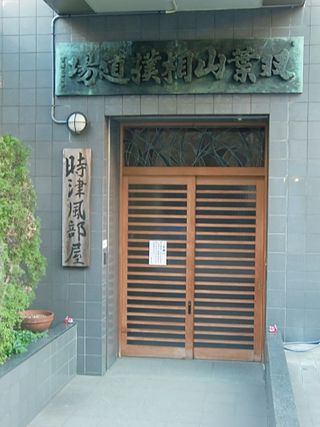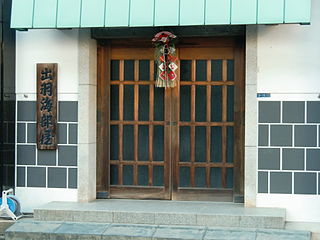
Aomori, officially Aomori City, is the capital city of Aomori Prefecture, in the Tōhoku region of Japan. As of 1 August 2023, the city had an estimated population of 264,945 in 136,781 households, and a population density of 321 people per square kilometer spread over the city's total area of 824.61 km2 (318.38 sq mi). Aomori is one of Japan's 62 core cities and the core of the Aomori metropolitan area.
The Japan Sumo Association, sometimes abbreviated JSA or NSK, is the body that operates and controls professional sumo wrestling in Japan under the jurisdiction of the Japanese Ministry of Education, Culture, Sports, Science and Technology (MEXT). This means concretely that the Association maintains and develops sumo traditions and integrity by holding tournaments and tours. The purposes of the Association are also to develop the means dedicated to the sport and maintain, manage and operate the facilities necessary for these activities. Therefore, the JSA operates subsidiaries such as the Kokugikan Service Company to organize its economic aspects, the Sumo School to organize training and instruction or the Sumo Museum to preserve and utilize sumo wrestling records and artifacts.
Ryōgoku Kokugikan, also known as Ryōgoku Sumo Hall or Kokugikan Arena, is the name bestowed to two different indoor sporting arenas located in Tokyo. The first Ryōgoku Kokugikan opened its doors in 1909 and was located on the premises of the Ekōin temple in Ryōgoku, Tokyo. Although no sumo bouts were held after 1945, following the capitulation of Japan and the requisition of the building by the occupying forces, the building itself remained active until 1983, being notably used by the Nihon University. The second Ryōgoku Kokugikan is currently located in the Yokoami neighborhood of Sumida next to the Edo-Tokyo Museum. It opened in 1985, following the closure of the Kuramae Kokugikan, and is still in use today.

Ryōgoku (両国) is a district in Sumida, Tokyo. It is surrounded by various districts in Sumida, Chūō, and Taitō wards: Yokoami, Midori, Chitose, Higashi Nihonbashi, and Yanagibashi.

Hakkaku stable is a stable of sumo wrestlers, part of the Takasago ichimon or group of stables. It was established in September 1993 by former yokozuna Hokutoumi, who took with him four wrestlers from Kokonoe stable. The stable has so far produced nine sekitori, four of whom have reached the makuuchi division. As of January 2023, it had 21 wrestlers.

Kokonoe stable is a stable of sumo wrestlers, one of the Takasago group of stables. It was formed in 1967 and until 2021 was located in Ishiwara, Sumida, Tokyo. As of January 2023 it had 26 sumo wrestlers, four of whom are of sekitori rank. It is the most successful stable in terms of total yūshō won by its wrestlers, with 52.
The following words are terms used in sumo wrestling in Japan.

Kataonami stable is a stable of sumo wrestlers, part of the Nishonoseki ichimon or group of stables. It was founded in 1961 by former sekiwake Tamanoumi Daitarō, who branched off from Nishonoseki stable. Former sekiwake Tamanofuji took over the running of the stable upon Tamanoumi's death in 1987. In February 2010 he passed control over to another former sekiwake, Tamakasuga, remaining in the stable under the elder name Tateyama. As of January 2023 it had four active wrestlers. The March 2023 tournament saw the first promotion to the jūryō division for the stable since the former Tamakasuga took over as head coach, with Tamashōhō becoming its first new sekitori since Tamawashi in January 2008.

Azumazeki stable was a stable of sumo wrestlers, part of the Takasago group of stables. It was founded in February 1986 by the Hawaiian born Takamiyama of the Takasago stable in Higashi–Komagata, Sumida, Tokyo. It was the first stable ever to be run by a foreign-born coach. Azumazeki's first sekitori was Akebono, also from Hawaii, in 1990, who subsequently reached the yokozuna rank. A total of nine foreign born wrestlers have fought for the stable: seven from the United States, one from Great Britain and one (Kosei) from China who retired in January 2017. The stable's first Japanese sekitori was Takamisakari. As of January 2021 it had seven wrestlers.

Nishikido stable is a stable of sumo wrestlers, one of the Takasago group of stables. It was founded in 2002 by Mitoizumi of the Takasago stable.

The Tokitsukaze stable is a stable of sumo wrestlers in Japan, one of the Tokitsukaze group of stables. It was founded in 1769 and was dominant during the Taishō period.

Dewanoumi stable is a stable of sumo wrestlers, part of the Dewanoumi ichimon or group of stables. It has a long, prestigious history. Its current head coach is former maegashira Oginohana. As of January 2023 it had 19 wrestlers.

Kasugano stable is a stable of sumo wrestlers, part of the Dewanoumi ichimon or group of stables. As of January 2023 it had 17 wrestlers. It has been led by former sekiwake Tochinowaka Kiyotaka since 2003. It was one of the most successful stables in 2013, with six sekitori wrestlers, including now retired Georgian Tochinoshin and Japanese born Tochinowaka Michihiro, who used the current head coach's old ring name.

Ōshima stable, formerly known as Tomozuna stable, is a stable of sumo wrestlers, part of the Isegahama ichimon or group of stables. As of January 2023, it has seven wrestlers.
The following were the events in professional sumo during 2015.

Naruto stable is a stable of sumo wrestlers, part of the Nishonoseki ichimon or group of stables, and founded by former sumo wrestler Kotoōshū Katsunori on 1 April 2017.
The following are the events in professional sumo during 2023.
The Sumo Museum is an institution located in the Ryōgoku Kokugikan arena in Sumida, Tokyo. The museum is managed by the Japan Sumo Association.

Ayasegawa Sanzaemon was a Japanese sumo wrestler from Higashinari, Settsu Province. His highest rank was ōzeki. He is the first wrestler from Osaka Prefecture to have been promoted at this rank in sumo history, and the only one until Ōnishiki's promotion in 1916, 44 years later.

Otowayama stable is a stable of sumo wrestlers, part of the Tokitsukaze ichimon, or group of stables. It was formed by the 71st Yokozuna Kakuryū in December 2023 after he became independent from Michinoku stable. As of January 2024, the stable has 2 wrestlers.














